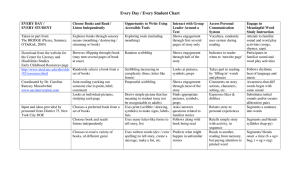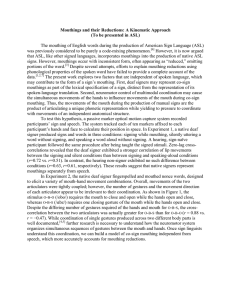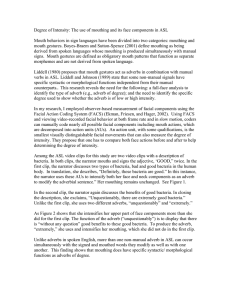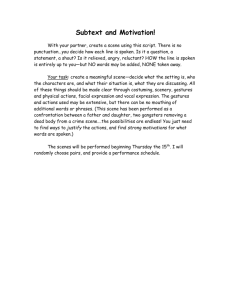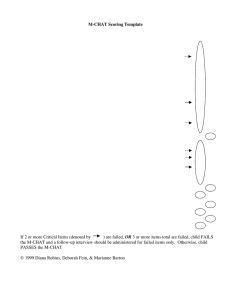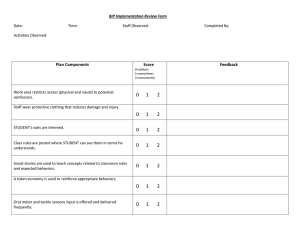Uploaded by
Leana Bernardes
Noncontingent Food & Object Mouthing: A Behavior Analysis Study
advertisement
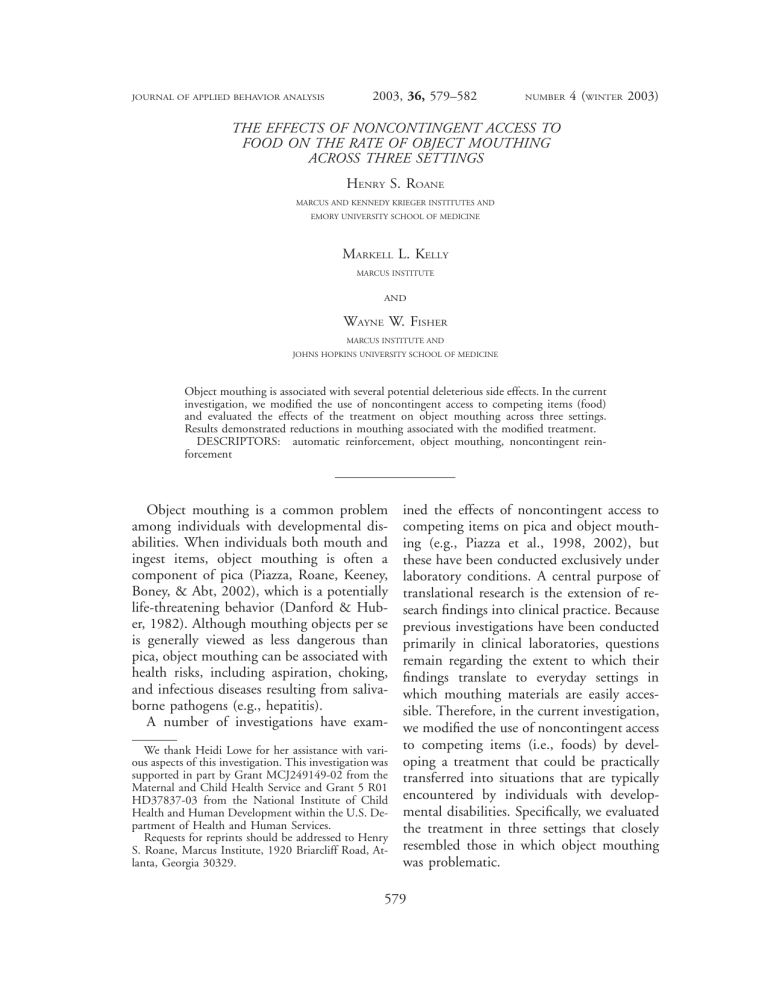
JOURNAL OF APPLIED BEHAVIOR ANALYSIS 2003, 36, 579–582 NUMBER 4 (WINTER 2003) THE EFFECTS OF NONCONTINGENT ACCESS TO FOOD ON THE RATE OF OBJECT MOUTHING ACROSS THREE SETTINGS HENRY S. ROANE MARCUS AND KENNEDY KRIEGER INSTITUTES AND EMORY UNIVERSITY SCHOOL OF MEDICINE MARKELL L. KELLY MARCUS INSTITUTE AND WAYNE W. FISHER MARCUS INSTITUTE AND JOHNS HOPKINS UNIVERSITY SCHOOL OF MEDICINE Object mouthing is associated with several potential deleterious side effects. In the current investigation, we modified the use of noncontingent access to competing items (food) and evaluated the effects of the treatment on object mouthing across three settings. Results demonstrated reductions in mouthing associated with the modified treatment. DESCRIPTORS: automatic reinforcement, object mouthing, noncontingent reinforcement Object mouthing is a common problem among individuals with developmental disabilities. When individuals both mouth and ingest items, object mouthing is often a component of pica (Piazza, Roane, Keeney, Boney, & Abt, 2002), which is a potentially life-threatening behavior (Danford & Huber, 1982). Although mouthing objects per se is generally viewed as less dangerous than pica, object mouthing can be associated with health risks, including aspiration, choking, and infectious diseases resulting from salivaborne pathogens (e.g., hepatitis). A number of investigations have examWe thank Heidi Lowe for her assistance with various aspects of this investigation. This investigation was supported in part by Grant MCJ249149-02 from the Maternal and Child Health Service and Grant 5 R01 HD37837-03 from the National Institute of Child Health and Human Development within the U.S. Department of Health and Human Services. Requests for reprints should be addressed to Henry S. Roane, Marcus Institute, 1920 Briarcliff Road, Atlanta, Georgia 30329. ined the effects of noncontingent access to competing items on pica and object mouthing (e.g., Piazza et al., 1998, 2002), but these have been conducted exclusively under laboratory conditions. A central purpose of translational research is the extension of research findings into clinical practice. Because previous investigations have been conducted primarily in clinical laboratories, questions remain regarding the extent to which their findings translate to everyday settings in which mouthing materials are easily accessible. Therefore, in the current investigation, we modified the use of noncontingent access to competing items (i.e., foods) by developing a treatment that could be practically transferred into situations that are typically encountered by individuals with developmental disabilities. Specifically, we evaluated the treatment in three settings that closely resembled those in which object mouthing was problematic. 579 580 HENRY S. ROANE et al. METHOD Jason, an 8-year-old boy who had been diagnosed with autism, cerebral palsy, and moderate mental retardation, was enrolled in a full-day (6-hr) program for the assessment and treatment of multiple topographies of destructive behavior, including object mouthing. Jason had a history of mouthing different objects including cloth, toys, paper, plants, tree bark, and dirt. Prior to the current analysis, a functional analysis, preference assessment (to identify stimuli that competed with the occurrence of object mouthing), and initial treatment analysis were conducted in a manner similar to that described by Piazza et al. (1998). That is, during these analyses, Jason’s mouthing was assessed in a therapy room (3 m by 3 m) that was baited with objects deemed safe for mouthing and similar to the items that Jason typically mouthed (e.g., plastic objects, foam puzzle pieces, books). Results of the functional analysis showed that mouthing persisted at relatively high levels in the ignore, play, and social attention conditions and at somewhat lower levels in the demand condition. Consistent with the hypothesis that mouthing was maintained by automatic reinforcement, the response also persisted in a series of three 30-min ignore sessions. During treatment, continuous access to competing items (foods) reduced levels of mouthing relative to baseline. Following the initial set of analyses, the effectiveness of a modified treatment for mouthing was evaluated across three settings in which mouthing had been identified as problematic. The classroom setting was an area of a classroom that was used for individual and group instruction and that contained books, plastic blocks and containers, personal grooming utensils, and various teaching materials (e.g., workbooks). The playroom setting was a room connected to a waiting area that was commonly used by children during unstructured time. This room contained a variety of toys, a large foam puzzle, and a tub of plastic balls. The outdoor setting was a grass-covered area located adjacent to the building that contained trees, dirt, grass, pine straw, and wood chips. Observers, seated in unobtrusive positions in one of the target settings, collected data on the frequency of object mouthing (defined as placement of an inedible object past the plane of the lips) and food consumption (defined as placement of food past the plane of the lips). Frequency measures were converted to a rate by dividing the number of occurrences of either object mouthing or food consumption by the length of the session (in minutes) to yield an average number of responses per minute. It should be noted that object mouthing typically constituted a discrete episode rather than a continuous event. In addition, Jason often placed multiple objects (both inappropriate items and food) in his mouth simultaneously. Exact agreement coefficients for mouthing and food consumption were calculated by dividing the number of agreements (two observers recording the same number of occurrences within a given 10-s interval) by the number of agreements plus disagreements and multiplying by 100%. Reliability data were collected on 33% of the sessions and averaged 95.6% for object mouthing and 90.4% for food consumption. Two conditions were implemented across all settings. The baseline condition was developed based on the functional analysis results, which showed that mouthing was maintained by automatic reinforcement and occurred independent of social consequences. During baseline, a therapist was present (approximately 1.5 to 3 m from Jason), but all occurrences of mouthing were ignored (i.e., no social consequences were arranged for mouthing, and Jason was allowed to place items in his mouth). No food items were available during baseline. The treat- OBJECT MOUTHING 581 Figure 1. Responses per minute of mouthing during baseline and treatment with the fanny pack across three settings. ment condition was identical to baseline except that Jason had continuous access to foods that had been previously identified to compete with the occurrence of object mouthing: chewing gum, marshmallows, and hard candy. Jason wore a fanny pack containing these items around his waist. The treatment evaluation was conducted in a multiple baseline design across settings. Three to five 10-min sessions were conducted daily. RESULTS AND DISCUSSION Figure 1 shows the outcome of the modified treatment implemented across the three settings. During baseline, mouthing averaged 0.9, 1.1, and 1.2 responses per minute in the classroom, playroom, and outdoor settings, respectively. In treatment, rates of mouthing dropped to 0.01, 0.01, and 0.07 responses per minute in the classroom, playroom, and outdoor settings, respectively. The average rates of food consumption 582 HENRY S. ROANE et al. across the classroom, playroom, and outdoor settings were 1.1, 0.9, and 0.8 responses per minute. Results of the current investigation, combined with those of prior studies (Piazza et al., 1998, 2002), demonstrate the clinical utility of using noncontingent access to competing items in the treatment of automatically reinforced object mouthing. The current results also extend previous research by demonstrating the effects of noncontingent access to competing stimuli in settings that closely resemble those in which the behavior might occur. Furthermore, the modified treatment involved low-effort access to the competing stimuli and was easily transferred across all settings. The use of the fanny pack allowed the participant to have easy access to the competing stimuli. Piazza et al. (2002) showed that levels of pica may be influenced by the level of effort required to access both pica items and competing stimuli. The current treatment package ensured that the competing stimuli were always available to the participant. The current investigation is limited by the participation of only one individual and the relatively brief (10-min) nature of the observations (i.e., the long-term effects of the modified treatment are unknown). In addition, the continuous provision of food may represent an initial treatment strategy that may be as efficient as other treatments (e.g., noncontingent access to leisure items, response blocking). However, continuous provision of food may result in satiation, which may recreate the establishing operation for object mouthing (deprivation of oral stimulation). Thus, an alternative and perhaps more effective replacement behavior may involve manipulation of leisure materials. Although the use of leisure items may require additional training (e.g., shaping appropriate manipulation) relative to food consumption, the long-term use of leisure items may be more beneficial than the noncontingent provision of food. REFERENCES Danford, D. E., & Huber, A. M. (1982). Pica among mentally retarded adults. American Journal of Mental Deficiency, 87, 141–146. Piazza, C. C., Fisher, W. W., Hanley, G. P., LeBlanc, L. A., Worsdell, A. S., Lindauer, S. E., et al. (1998). Treatment of pica through multiple analyses of its reinforcing functions. Journal of Applied Behavior Analysis, 31, 165–189. Piazza, C. C., Roane, H. S., Keeney, K. M., Boney, B. R., & Abt, K. A. (2002). Varying response effort in the treatment of pica maintained by automatic reinforcement. Journal of Applied Behavior Analysis, 35, 233–246. Received May 7, 2002 Final acceptance August 12, 2003 Action Editor, Brian Iwata
